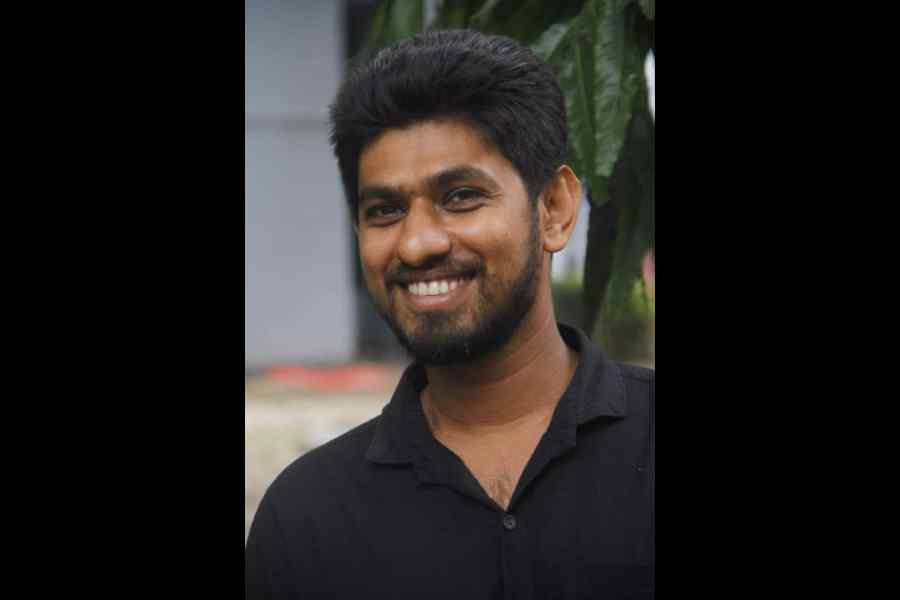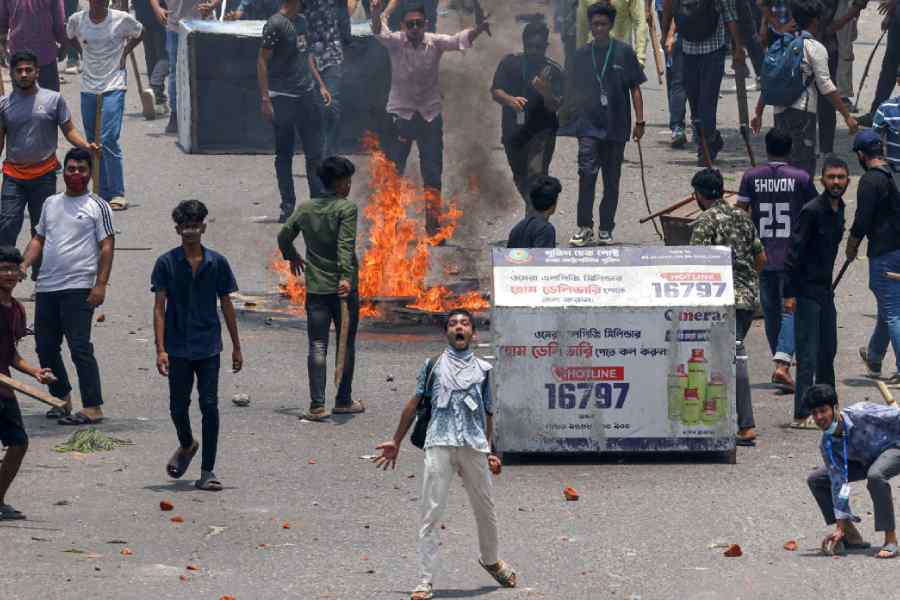A 17-year-old student and a journalist were among at least 19 people reported killed in Bangladesh on Thursday as security forces and turbulent quota protesters clashed across the country after movement leaders spurned a dialogue with the Sheikh Hasina government.
As India’s most trusted neighbour teetered on the brink of crisis, its government and security establishment alleged that armed cadres of the Jamaat-e-Islami and Bangladesh Nationalist Party (BNP) had taken over what had begun as a student movement and engineered the violence.
The protesters succeeded in enforcing a total nationwide shutdown — something Bangladesh had not witnessed in recent years — reflecting the enormity of the challenge facing Hasina, who returned to power for a fourth straight term earlier this year after a controversial election.
Even schoolchildren and their parents were spotted in protest marches across the country, a testimony to the widening sweep of a movement that had begun with a student demand for the withdrawal of the 30 per cent reservation in government jobs for relatives of freedom fighters.
Amid speculation on how the Awami League government would tackle the crisis, a source said Hasina had instructed all senior ministers and party leaders who were travelling in other regions to return to Dhaka by Thursday night.
“It is no longer a student protest for quota reforms…. It has metamorphosed into a rebellion against the government as Opposition forces have taken control of the movement, which was started by a few hundred students barely a fortnight ago,” a source said.

Mehedi Hasan, a reporter with news portal Dhakatimes24.com, died of a bullet injury during clashes in Jatrabari, Dhaka, on Thursday. PTI news
Reports said the government was considering legal remedies to tackle the situation at the earliest.
To try and scatter the protesters, the authorities had closed down all academic institutions indefinitely and cleared out hostels on Wednesday.
Riot police and the elite Border Guard Bangladesh (BGB), a paramilitary force, were deployed across campuses over the last 24 hours.
But these measures could not stop tens of thousands of students from clashing with law enforcers across the country and vandalising private and public property.
“This scale of violence can be perpetrated only by the foot soldiers of the Jamaat-e-Islami…. The Jamaat and its ally BNP had been conspiring to destabilise the government, and they used the students to create a crisis,” a source in the security establishment said.
Foreign advisories
As horrific scenes from Dhaka swamped social media, showing public broadcaster Bangladesh Television’s office on fire, armoured personnel carriers patrolling the main thoroughfares, and a helicopter deployed to rescue policemen from a university, foreign missions issued alerts for their citizens currently in Bangladesh.
“There were scenes of a helicopter airlifting policemen from a campus where they had got stranded…. It was scary and I was expecting advisories from Western countries,” said a diplomat who had been in Dhaka till two years ago.
The Indian high commission issued an urgent advisory for Indian nationals, including students, in Bangladesh asking them to avoid travel and minimise movement outside their living premises.
The US embassy in Dhaka issued a similar advisory.
“Things seem to have completely spun out of control.... We are living in fear,” Dulal Chandrow Gain, a professor in the department of drawing and painting at Dhaka University, told this newspaper.
Epicentre Dhaka
While the whole of Bangladesh has been on the boil for the last 72 hours or so, the nucleus of the agitation on Thursday was the capital where at least 13 lives were lost in a single day.
Dhaka witnessed violence across some of its elite campuses such as Brac University, North South University, Northern University and the Dhaka Residential Model College. At least four people were killed and over 1,000 injured in the city’s Uttara locality alone during a clash between quota protesters and the police.
A 17-year-old student of the Dhaka Residential Model College was killed during a clash in the Dhanmondi locality.
Mehedi Hasan, a reporter with the news portal Dhakatimes24.com, died of a bullet injury in Dhaka’s Jatrabari area while covering the clashes.
Following the arson at BTV, which was attacked by hundreds of protesters in the afternoon, transmission was stopped. The Internet was down amid reports that the authorities had suspended services. Several BGB vehicles were torched; a police station in Uttara was under gherao; government offices were attacked across the country.
Dialogue proposal
Law minister Anisul Huq had appealed to the students to come to the talks table on Thursday morning, but the movement leaders rejected the proposal through multiple Facebook posts.
“When the roads are soaked in the blood of our fellow protesters, going on a dialogue with the government, which used its agencies to fire bullets on us, is not possible,” Nurul Haque Nur, a student leader who had led the quota reform movement of 2018 and is guiding the current agitation’s leaders, told this newspaper.
Communication
In the face of protests, the Hasina government had abolished the quotas in 2018, a move that was challenged in the high court. Earlier this month, the high court restored the 30 per cent quota, triggering the recent wave of protests.
In a televised address to the nation on Wednesday, Hasina had explained that the government had petitioned the Supreme Court against the high court order and urged the students to be patient till the hearing, scheduled on August 7.
“The protesters’ main demand is congruent with the official position of the government, which is also opposed to the quota…. But still we are facing this crisis, and it’s because of some of the MPs and ministers who made statements favouring the quota,” a legal expert said from Dhaka.
“This contradiction between the positions of the government and some of its members created the provocation for the students to launch the movement…. And then sinister elements took over its control.”
Some civil society groups are saying the government should have reached out to the protesters earlier and engaged them in a constructive dialogue. A security analyst said the entire episode had also revealed the deficiencies in the country’s intelligence network.
“There are reports that Jamaat spent over 100 crore takas over the last month to prepare its foot soldiers for a movement against the government…. The agencies should have alerted the government,” the source said.











